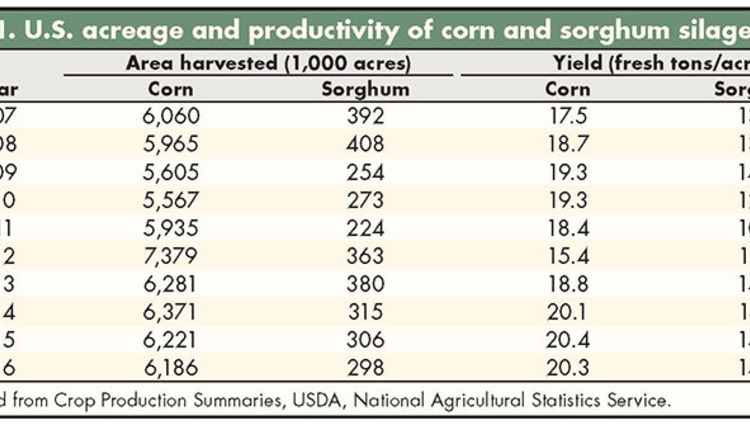Although corn silage is the predominant forage fed to dairy cows in the United States, sorghum has become an important silage crop as well. This is related to some of its unique characteristics. Compared to corn, sorghum uses water more efficiently, has lower fertilizer requirements, may potentially reduce soil erosion and pesticide usage, and has reduced seed and irrigation costs.
These characteristics are particularly desired in scenarios that introduce considerable risks for corn silage production, including delayed planting due to wet soils, elevated summer temperatures, drought, or areas where irrigation is unavailable. Furthermore, it can be used as a second crop after corn silage harvesting.
Alternatively, if forage sorghum is planted during the spring and allowed to develop new tillers, it can be harvested twice without replanting. Due to all these factors, approximately 300,000 acres of sorghum were harvested for silage in the United States in 2016 (see Table 1).

Although sorghum silage can be successfully used in dairy cattle diets, some challenges must be considered prior to its incorporation. Therefore, the purpose of this article is to review factors that affect the efficacy of implementing sorghum silage as an alternative crop on dairy farms.
There are differences
Table 1 has total area harvested and yield in the United States from 2007 to 2016. Acreage of corn is 20-fold greater than sorghum for silage production. Furthermore, the national average for sorghum yield per acre was 5.5 fresh tons per acre, on average, lower for sorghum than corn in the last 10 years.
Last summer, during the American Dairy Science Association (ADSA) national meetings, researchers from Virginia Tech and University of Florida presented a collaborative retrospective study that confirmed these numbers (see Table 2). This study summarized data from the corn, forage sorghum, and sorghum-sudangrass performance trials at the University of Florida between 2008 and 2014. Regardless of crops being planted during the spring or summer seasons, dry matter (DM) yield was lower for both types of sorghums compared to corn silage. This is important because it affects forage inventory.

Additional information provided by that study was the differences in nutrient composition and digestibility. Typically, sorghum plants have greater neutral detergent fiber (NDF) and lignin concentration than corn plants. This is related to the greater proportion of total mass being comprised by stem than by leaves and grain in sorghum plants. Because the cross-linking of lignin to other fibrous components is the foremost limiting factor of NDF digestibility, reduced ruminal in vitro NDF digestibility (ivNDFD) in sorghum plants, regardless of type, is observed.
The lower proportion of grain in the total mass also explains the reduced concentration of starch in sorghum plants. Besides having less starch, sorghum naturally has lower starch digestibility than corn. Starch in cereal grains are surrounded by proteins (prolamin proteins) that inhibit digestion of starch in the rumen and small intestine of dairy cows.
Although these proteins affect corn and sorghum, the type of prolamin proteins found in sorghum is more difficult to break down than in corn and, thus, less starch is available for digestion. Therefore, estimates of milk production per unit of silage are lower for sorghum than corn as energy predictive equations are based on starch and NDF. The figure has a summary of milk per-ton estimates from the University of Florida Variety Performance Trials, which demonstrates why we often have reduced milk yield when cows are fed sorghum silage.
These factors emphasize specific requirements when implementing sorghum as an alternative crop: 1) hybrid selection based on yield and quality; and, 2) replacement of corn silage on a fiber basis rather than DM basis.
Target hybrids that combine improved DM yield with enhanced ivNDFD is a key factor. Similar to brown midrib (BMR) hybrids in corn, sorghum has BMR hybrids with improved fiber digestibility. Because yield and nutritive value of hybrids varies in different regions and years, going through hybrid performance trial results within your region and across several years translates into more reliable hybrid choices for your farm.
Feeding sorghum
Diet formulation focused on replacing corn with sorghum silage requires adjustments for higher NDF and reduced starch content. A feeding trial from the University of Nebraska evaluated the replacement of corn silage with a conventional and two genotypes of BMR sorghum silage. Diets were not adjusted for starch and NDF concentration. As expected, the replacement of corn silage with conventional sorghum silage impaired milk production. However, BMR sorghum silage attenuated or eliminated this difference.
A recent experiment from the University of Georgia compared the use of a BMR brachytic dwarf sorghum hybrid from first and second harvest with conventional corn silage harvested during spring and summer. The researchers adjusted starch and NDF concentrations of the diets. Cows fed sorghum silage had similar milk production than their cohorts fed corn silage in this study.

Sorghum is a feasible alternative crop to corn for silage production; its benefits are exacerbated in areas with potentially delayed planting due to wet soil, elevated summer temperatures, drought, or areas where irrigation is unavailable. However, its greater fiber and lower grain content requires proper dietary adjustment when feeding
lactating cows.
Alternatively, it is a great option for animals with lower energy requirements; particularly growing heifers, dry cows, or late-lactation cows on farms with adequate nutritional grouping management. Team discussions, including crop consultants and nutritionists, are advised prior to the implementation of sorghum silage in dairy operations.
This article appeared in the April/May 2017 issue of Hay & Forage Grower on pages 24 and 25.
Not a subscriber? Click to get the print magazine.

